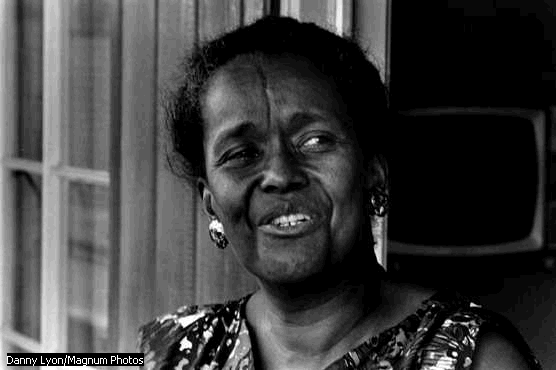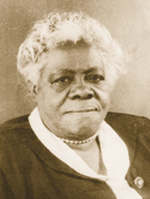 Ella
Baker
Ella
Baker
Ella Baker was born on Dec. 13, 1903, in Norfolk, Virginia. She developed a sense for social justice early in her life. As a girl growing up in North Carolina, she listened to her grandmother speak about slave revolts. As a slave, her grandmother had been whipped for refusing to marry a man chosen by her slave owner. She joined the Young Negroes Cooperative League. The League’s purpose was to develop black economic power though collective planning. She also involved herself with several women’s organizations. Ella Baker died on Dec. 13, 1986 in New York City.
 Mary
McLeod Bethune
Mary
McLeod Bethune
Mary McLeod Bethune was an
educator, an organizer, and a political activist. She made many contributions
to the African American Society. First, Mary started one of the first schools
for African American girls in Daytona Beach, Florida. Because she had very little
money, Mary used boxes and packing crates for desks. On October 3, 1904, the
Daytona Normal and Industrial School opened, with five pupils. Secondly, Mary
was the first African American woman to be involved in the White House, assisting
four different presidents. In 1928, President Calvin Coolidge asked Mary to
take part in a child care conference. In 1929, President Herbert Hoover called
on her to become a member of two important commissions. In 1933, Franklin D.
Roosevelt looked to Mary for help with the National Youth Administration. In
1951, Mary traveled to Africa on a mission for President Harry Truman. Next,
Mary was in charge of the Division of Negro Affairs in the National Youth Administration.
She worked hard to help young people find jobs. Also, she founded Bethune-Cookman
College (BCC) in 1923. Since 1943, BCC has had over 9,500 students graduate.
In addition, this college offers Bachelor degrees in 26 major areas. Throughout
her life, Mary encouraged African Americans to be proud they were American citizens.
She used her wisdom and talents to improve our society today.
Madam C.J. Walker became the first black American woman self-made millionaire. She was married at age fourteen, and widowed at twenty with a two-year-old daughter. She moved to St. Louis and decided to start her own line of hair-care products. By 1916 the Walker Company included 20,000 male and female agents, several schools, and manufacturing plants that operated in the United States, Central America, and the Caribbean. Madame Walker believed in philanthropy and donated to the YMCA, the NAACP, and the National Association of Colored Women. She also gave grants to Tuskegee and Palmer Memorial Institute.
Mrs. Rosa Parks, born on February 4, 1913, has been called the "mother of the civil rights movement" and one of the most important citizens of the twentieth century.
On December 1, 1955, Mrs. Rosa Parks refused to give up her seat near the front of a Montgomery, Alabama city bus to a white passenger. The bus driver had her arrested for violating the law. By "sitting down" for what she believed in, and refusing to give up her bus seat, Mrs. Parks made history. The following night, fifty leaders of the Negro community (among them was the young minister, Dr. Martin Luther King, Jr.) met to discuss the issue. The leaders organized the Montgomery Bus Boycott that would continue until the bus segregation laws were changed. The citywide boycott of the bus system by blacks, in which they refused to use the bus for transportation, lasted for 382 days. It caused the bus company to lose a huge amount of money -- and changed America forever.
In December of 1956, the Supreme Court decided that bus segregation violated the Constitution. The Civil Rights Movement was put into motion, which led to the Civil Rights Act of 1964. Today all Americans, whatever their race, nationality, or religion, must be given equal treatment under the law.
In 1955, the year of her famous bus incident, Mrs. Parks was forty-two years old, and was very well respected in the black community. But long before that day, she fought segregation in her own way. She walked up the stairs of a building rather than riding in an elevator marked "blacks only." She went home thirsty instead of drinking from the "colored only" water fountain. And, Mrs. Parks preferred to walk home from work whenever possible to avoid sitting in the "blacks only" section in the back of the city bus.
During the Montgomery Bus
Boycott, Mrs. Parks and her family received threats and were continually harrassed.
She was fired from her job as a seamstress, but didn't budge in her efforts
to fight for racial equality. In 1957 she and her husband moved to Detroit,
Michigan, where she again took in sewing and also worked as a fundraiser for
the NAACP. In 1965 she was hired by Congressman John Conyers, Jr., also a civil
rights leader, to manage his Detroit office. She and her husband remained active
in the NAACP and the Southern Christian Leadership Conference (SCLC).
|
|
|
|
|
|
|
|
|
|
|
|
|
|
|
|